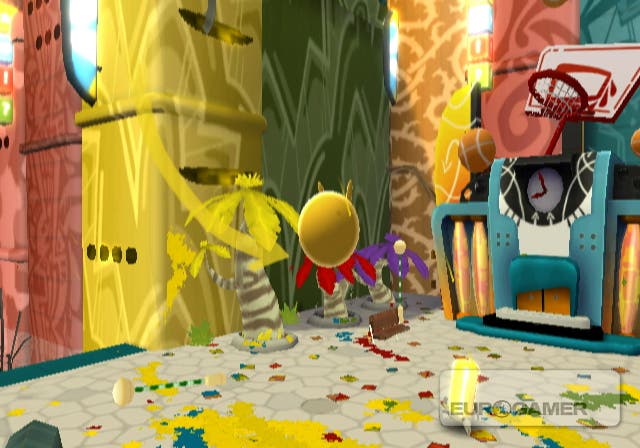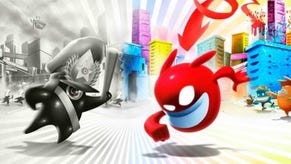de Blob
de Blicious.
One of the cheapest review tactics of all time is the old 'cut and shut' technique: in the struggle to eloquently sum up the merits of a particular product, the hard-pressed critic resorts to describing it as 'game A meets game B'. But sometimes, it's the only way. And if ever a game needed a concise, off the cuff, down-the-pub-with-your-mates description it's de Blob. Maybe you can help THQ out and come up with one.
de Blob might look like a McDonald's Happy Meal of a game, and with THQ behind it, you might assume this is some sort of Nickelodeon Mercury Meltdown - but that's not doing it any favours at all. Despite its Day-Glo visual style, it definitely shouldn't be dismissed as a kids' game, and nor is it strictly a ball-rolling puzzle game. It's something else entirely: something original, utterly charming and occasionally very exciting. At its most basic level, it's an intriguing 3D platform-puzzle hybrid, where restoring colour to a monochromatic city is your goal (hello Wizball!). Think of it as a gigantic interactive colouring-in playground. For grown-ups.
The premise is delightfully daft, and some superbly animated sequences help set the tone with a style and tone evocative of LucasArts' legendary Day of the Tentacle. For reasons best known to themselves, the nefarious I.N.K.T. Corporation has made colour illegal and literally drained the life out of every building, plant, sign and statue in Chroma City. Needless to say, this is where de Blob comes in, on a solo mission to fight back against The Man and reverse this dastardly deed to the sound of happy jazz. You're damn right.
As the title suggests, you control what looks like a grinning gelatinous space hopper around these monochromatic environments, rolling it around with the nunchuk analogue stick, and flicking it up in the air with an upward swish of the Wii remote. Dotted around the drab, grey and white confines of Chroma City are various waddling paint pots, and bashing into them changes the colour of de Blob accordingly. With some colour in your cheeks, you can then transform the decor of the nearest building or other scenery item by simply rolling or slamming into them.

Each district has a number of locked gates, and in order to progress beyond them you have to clock up a specific number of "colourwatts" before they'll open up and allow you to progress further. To amass the alloted number of points, you can simply roll and bound your jolly way around, colouring everything, in a slightly obsessive-compulsive kind of way.
Ensuring each 'block' of any given neighbourhood is filled with colour frees its enslaved inhabitants, but doing so often involves a fair bit of careful platform negotiation as you leap from one building to another to reach the high-up spots which help complete the set. As you might expect, restoring colour to the 'Graydian' populace sends them giddy with delight, with an exuberant chorus of 'woo-hoo!' as you rescue them from monochromatic doom. It's worth playing just to hear their high-pitched songs of joy. Not since LocoRoco has rescuing squishy alien life forms been so joyous.
But as rewarding as all this may be, a more effective (and often essential) means of making progress is to engage in the numerous mini-challenges dotted around the city. Set against the clock, the idea is often to paint a specific block the desired colour, or amass a certain volume of, say, red paint, jump up to an insertion point, shake the Wii remote and fill it up, as if you were rattling a spray can.
As you hit certain colour milestones (such as 25, 50 and 75 per cent of the level), paint trees, solve four different types of challenges, and other micro tasks, the game keeps a track of your progress via an exhaustive stats screen which reveals just how much there is to do in order to properly complete each of the ten levels. You'll soon realise that getting to the exit pool is only a part of the overall picture - mining each level for all its secrets and challenges is a big undertaking, and certainly gives the game an unexpected amount of replayability.





